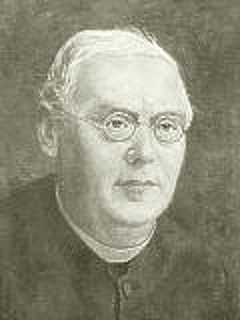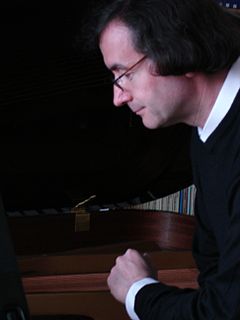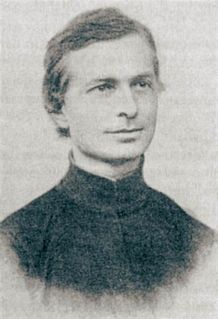In the theory of Western music, a mode is a type of musical scale coupled with a set of characteristic melodic behaviors. Musical modes have been a part of western musical thought since the Middle Ages, and were inspired by the theory of ancient Greek music. The name mode derives from the Latin word modus, "measure, standard, manner, way, size, limit of quantity, method".

Franz Xaver Haberl was a German musicologist, friend of Liszt, Perosi, and Singenberger, cleric, and student of Proske.

Monsignor Lorenzo Perosi was an Italian composer of sacred music and the only member of the Giovane Scuola who did not write opera. In the late 1890s, while he was still only in his twenties, Perosi was an internationally celebrated composer of sacred music, especially large-scale oratorios. Nobel Prize winner Romain Rolland wrote, "It's not easy to give you an exact idea of how popular Lorenzo Perosi is in his native country." Perosi's fame was not restricted to Europe. A 19 March 1899 New York Times article entitled "The Genius of Don Perosi" began, "The great and ever-increasing success which has greeted the four new oratorios of Don Lorenzo Perosi has placed this young priest-composer on a pedestal of fame which can only be compared with that which has been accorded of late years to the idolized Pietro Mascagni by his fellow-countrymen." Gianandrea Gavazzeni made the same comparison: "The sudden clamors of applause, at the end of the [19th] century, were just like those a decade earlier for Mascagni." Perosi worked for five Popes, including Pope Pius X who greatly fostered his rise.

Karl Proske, was a German Catholic cleric, also known as Carolus Proske and Carl Proske. In his youth, Proske was a medical doctor, and worked for the Prussian military during the 1813-15 engagement. In 1821 he entered the seminary, and was ordained in Regensburg on April 11, 1826. The following year, he was made a vicar choral of Regensburg Cathedral.

Franz Xaver Witt was a Catholic priest, church musician, and composer. He was a leading figure in the Cecilian movement for the reform of Catholic church music in the second half of the 19th century.
Church musician (Kirchenmusiker) is a music profession in Germany.

Friedrich Pustet GmbH & Co. KG is a German publishing firm, located in Regensburg.
The Hypolocrian mode is an almost entirely theoretical mode, introduced into chant theory in the 19th century by the editors of the Pustet-Ratisbon, Mechlin, and Rheims-Cambrai Office-Books, who designated it mode 12. It is the plagal counterpart to the authentic Locrian mode, mode 11 in that system of numbering, in which the Ionian and Hypoionian become modes 13 and 14. The ambitus of the mode lies between F and the F an octave higher, divided at the final, B. Its reciting tone, is E, and its mediant is D. It has two participants, G and C. Although a few plainchant melodies, as well as polyphonic compositions, have been attributed to this mode by some writers, it will generally be found that they are really derived, by transposition, from some other tonality.

The Allgemeiner Cäcilien-Verband für Deutschland was founded in 1868 and is an organization for choral singing of the Catholic Church. The official residence of the ACV is located in Regensburg. Approved by Pope Pius IX in 1870, the organisation represents over 417,000 singers in over 18,000 choirs. The organisation is named after the Patron Saint of music, St. Cecilia. It awards the Palestrina-Medaille, Ambrosius-Medaille and Orlando di Lasso-Medaille, among others.

Salvum fac populum tuum, WAB 40, is a motet composed by Anton Bruckner in 1884.

Pange lingua, WAB 33, is a sacred motet composed by Anton Bruckner in 1868. It is a setting of the Latin hymn Pange lingua for the celebration of Corpus Christi.

Ludger Stühlmeyer is a German cantor, composer, docent and musicologist.
Joseph Hanisch was a Bavarian, Roman Catholic organist and conductor. Hanisch was based in Regensburg from 1829 until his death in 1892.

Musica sacra is a magazine about sacred music, published by the Allgemeiner Cäcilien-Verband für Deutschland (ACV). It is the oldest trade paper for Catholic church music, especially liturgical music, still publishing in Germany. The magazine informs also about ecumenical perspectives in church music. Musica sacra reports events of the association, and news from other organisations, such as the Bundesverband katholischer Kirchenmusiker Deutschlands and the Pueri Cantores. Musica sacra appears six times per year, printed by Bärenreiter in Kassel in 3,500 copies.

Joseph Hermann Mohr was a German Catholic priest, a Jesuit, hymn writer, and hymnologist. He was a member of the Society of Jesus. When all its institutions were closed due to the Jesuits Law of 1872, he left Germany. He returned in 1882 and worked as a hymnologist.
Walter Blankenburg was a German Protestant pastor, director of church music and musicologist, who focused in several publications on liturgy, hymnology, and on the sacred music of the early Baroque period, especially by Johann Sebastian Bach.
Ulrich Aloysius Konrad is a German musicologist and professor at the Institute for Music Research of the University of Würzburg. He is considered an expert on European music of the 17th to 20th centuries, especially the works of Mozart, Robert Schumann, Richard Wagner and Richard Strauss. He wrote a biography, Wolfgang Amadé Mozart, and studied the composer's sketches.

Moritz Brosig was a German cathedral organist and composer. He came to be seen as a leading representative of the so-called Breslau School of church musicians. Despite his Roman Catholic faith, he wrote more than thirty chorale preludes, working in a musical genre more traditionally associated with Lutheran worship.

Carl Josef Thiel was a German organist, church musician and professor of music.
Franz Fleckenstein was a German church musician, priest and composer.















